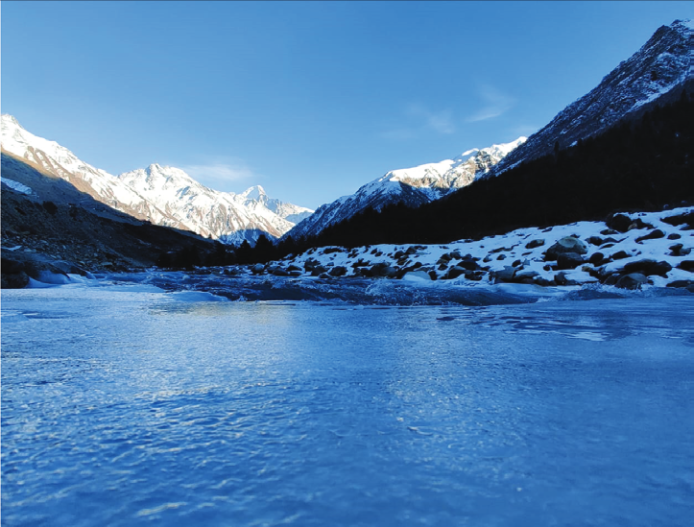Chitkul is a sheer token of Mother Nature’s blessing, away from the cacophony of maddening, bustling city life. The serenity that its scenic locales offer is just the solace one craves for. A mesmerised Shikha Hazarika sketches the majesty of a place that is not just about the regulation landscapes and tranquility but also about its people. The credit is to its responsible and hospitable inhabitants who jealously guard its glory.
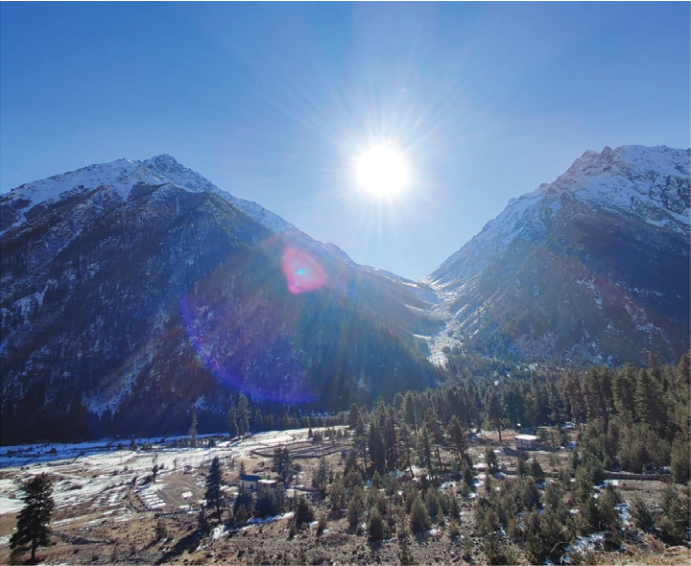
After two years of being cooped up inside the four walls of the house, the intensity of people travelling with a vengeance – ‘revenge travel’, as the phenomenon is called, is at a threshold of a new age of move. The rage for solo trips and workations has soared up being parallel to family or group trips exploring and endorsing the roads and destinations less taken. And if you’re planning for such escapism, then a trip to Chitkul will never disappoint you.
For those who don’t know, Chitkul nestled in Sangla Valley of Kinnaur district in Himachal Pradesh is the last motorable settlement on the old Indo-Tibetan trade route and the last point in the country people can travel to without permit. With Kinner Kailash in the backdrop, Chitkul boasts its unparalleled beauty on the banks of Baspa River which runs through the valley for 95 km before merging with River Sutlej at Karcham.
Embarking on a soul-stirring trail…
The best time to visit this picturesque village is between May and October but the travel bug inside me insisted I take up a little more challenge and experience the churlish winter. So, I along with two of my friends; ended up reaching the hamlet during a minus 15 degree Celsius. It was after decades that the valley had so little snowfall in December. Usually, the roads during December are covered with thick snow, making it almost impossible to maneuver.
As we diverted for Sangla from Karcham, the roads became rougher and narrower. The weather-beaten road has potholes and for long stretches is allows only one vehicle to pass. Meanwhile, it was also thrilling to move in that bumpy and greasy way with the motorable road ending right at the village. It was almost night when we reached Chitkul. The silence in the hills was haunting but one glance at the star-studded sky lifted up our mood despite the tiresome journey.
Sojourn in the village…
After experiencing a bone-chilling cold night, we woke up to a bright sunny morning. What could be a better start to a day, when one is amidst a range of ice-cladded mountains complemented by the cobalt blue skies with pointed peaks busting the clouds. Little wonder, the village has the cleanest air and makes one forget the treacherous roads to this paradise!

Also, by making the choice of staying at ‘Traveller’s Homestay’ on the main roadside, we felt fortunate to see everything at an altitude of 11,320 feet: majestic mountains, babbling river, large boulders and the exquisite meadows. The homestay run by Hansraj Negi, a local who gave up his engineering career to come back to his native village, can serve as a perfect halt for backpackers. One might not find extravagance here but it gives you a comfortable stay, great local experiences, awesome food and a memorable time. So, having doubled the energy with an appetizing breakfast, we headed out to explore the raw but pristine area.
Caught in the captivating views…
There is so much to do in the village itself and even more to cover around it! It is worth mentioning that the organic and unadulterated atmosphere of Chitkul makes it a popular site for backpackers, hikers and explorers.
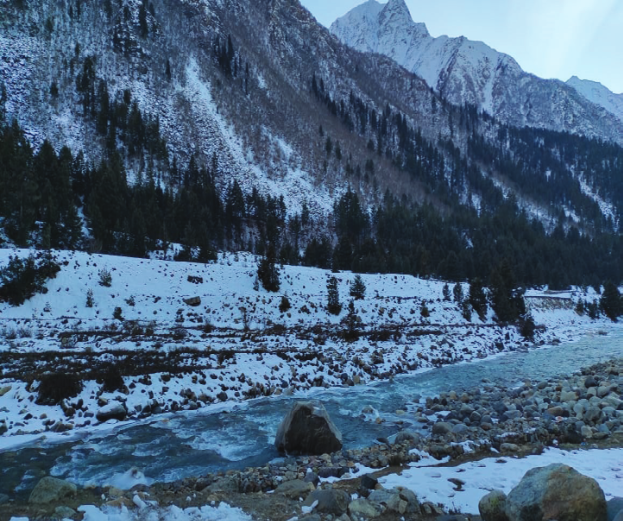
The first thing we decided was to walk to the pebble-strewn river side. The Baspa River, also known as the Angler’s Paradise, is an attraction, reminding you how blissful it is to be in the mountains. The pleasure of watching the sun rising from behind the peak making the mountains look like wearing a golden crown; will etch in your mind. As one gets closer to the Baspa River, you see a heavenly beauty which flows through the narrow valleys covered with nearly whiteout pine trees and snow-capped Himalayan peaks. The crystal-clear water almost in the verge of getting frozen is a treat to the eyes and in summers, one can experience trout fishing (especially, brown trouts) as one of the best activities in the valley. We also learned that some of the famous trekking routes in the region begin here. The Borassa Pass trek, at a height of nearly 18,000 feet, is one of the toughest. The Lamkhaga Pass trek takes at least 15 days. The Rani Kanda Meadows is just 10 km from Chitkul and this trek is of medium difficulty. For beginners, Nagari ITBP trek is the best.
The Sangla (Baspa) Valley is perhaps the most romantic valley in the state and is believed to have been descended from the Kinnars, the mythological musician-lovers of the human-bird kind. Kinnaur is surrounded by Garhwal in the south, Tibet in the east, Spiti Valley in the north and Kullu Valley in the west.
Weaving through the hamlet….
Having spent enough leisure time near the river, we decided to explore the village learning more about the life there and there couldn’t have been a better choice than Hansraj, owner Homestay. Unlike other property owners, he was humble and approachable. Without hesitation; he accompanied us through the area narrating all important facts and beliefs about the place.
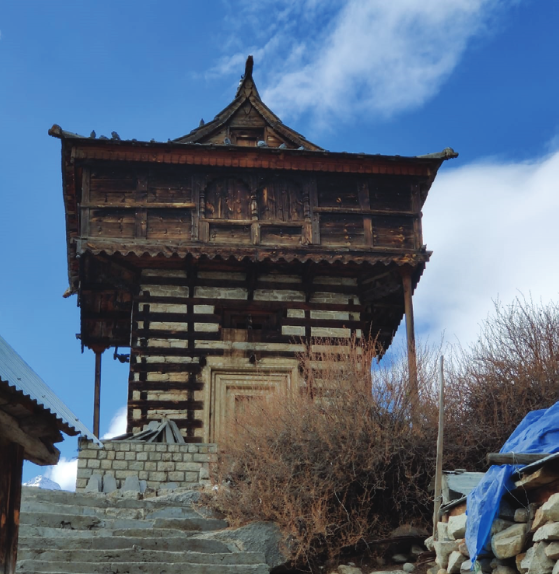
With a population below 1000, the layout of this place is typical of the region – a clustered hillside village pattern with narrow, steep and meandering footpaths, some made of concrete or stone while others are of mud, just wide enough for two people to walk. The most appealing feature of Chitkul is its old wooden houses exhibiting the finest vernacular architecture. However, there is a variation in the styles of the houses. No two houses are alike or in same scale even though they are close together.
The uniqueness in architecture is also reflected in the famous Chitkul Fort that towers over the village which is locally referred as ‘quila’, but is actually a shrine. This is a three-storey tower-like structure made of stone and wood with a small shrine on the topmost storey. The unusual wooden construction of Mathi Devi Temple is another architectural gem. Set in the middle of the village, the temple has intricate wooden carvings and distinctive roof profile. These distinctive structures dot the landscape, as do the abundant apple, walnut and apricot orchards which boost the vibrancy of the village in summers.
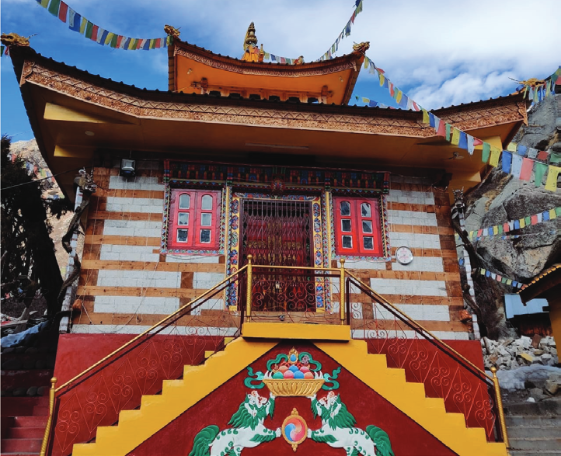
To our surprise, it was noticed that the villagers still use centuries-old ‘gharat’ or water mill for grinding grains. The entire village depends on the gharats established along the perennial stream that flows from a spring in the upper most mountains of the village.
Walking through the narrow trails, it was easy to perceive that the culture here is also diverse. A blend of Hinduism, Buddhism and Animism could be seen in the population with a Tibeto-Burman dialect spoken locally known as ‘Kinnauri’. Locals could be seen wearing their ubiquitous green Kinnauri (Pahadi) caps. Interestingly, to this date, people believe in the tales that have been going rounds for centuries. Unlike the people in the other towns of Kinnaur district, the original inhabitants of Chitkul and neighbouring villages have no trace of mongoloid features. As per the legends, the people of Chitkul were known as Kinnaras as they were believed to be halfway between a mortal and a deity. Some researchers have traced their ethnicity to the Khamba tribe of eastern Tibet and some associate them to the dards of Northern Himalayas but the true origin remains a mystery.
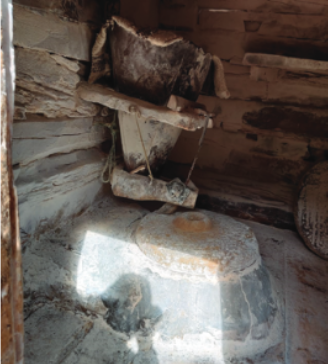
Unfolding the fascinating folktales…
The remarkable aspect of this village lies in its legends. The more you try to dig out the deep-rooted history of this heavenly abode, the more you fall. There is no authentic historical record of the earlier times of the village but there are fascinating folktales narrated by the locals that give you dim glimpses of the history.
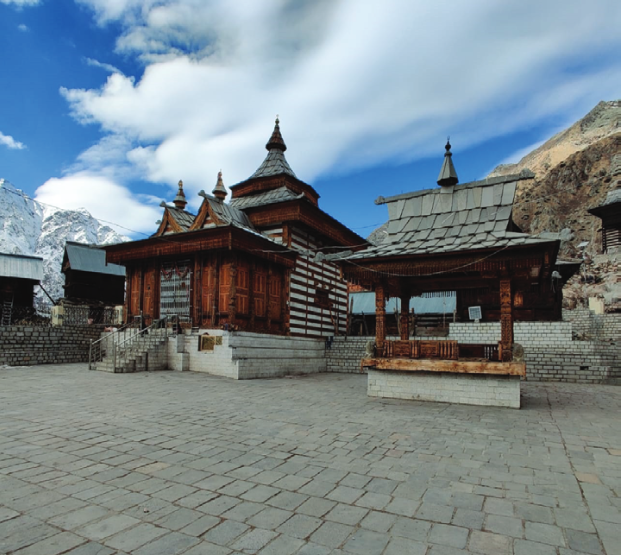
Such goes the legendary tale about the 500-year-old Mathi Devi Temple which is located in the centre of the village and is one main attraction for the tourist. It is believed that, Mathi Devi, the local deity of Chitkul, started her quest along with her family from Vrindavan via Mathura and later reached Tibet. On the way, she encountered the seven provinces in the valley of Barua Khad where the land was divided into seven parts. After deploying her nephews and husband as guards in the various provinces, she finally decided to settle here in Chitkul. It is also said that after her arrival, the village had begun prospering and growing in abundance with food and grass to graze for the cattle. The folklore also tells that the presiding deity of the neighbouring village of Kamru, Lord Badrinath, is her husband and the Nag Devta of Sangla and Shamshare Devta of Rakcham are her nephews.
All this made the villagers worship her and till date, the belief keeps getting firmer each passing day making the temple a prominent place for the locals to come and seek her blessings to overcome their miseries and shortcomings. Not only this, each year, during local festivals, villagers tell tales of yore celebrating the Goddess and the legends surrounding her.
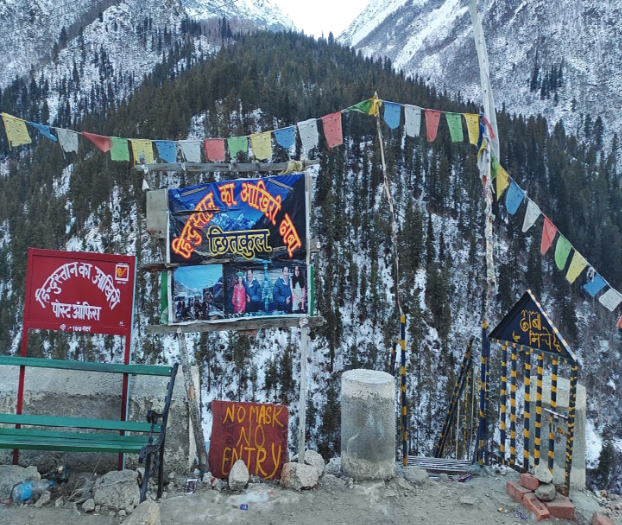
Hindustan ka Aakhri Dhaba…
Relishing the beauty of the peaceful settlement, we could not restrain our taste buds craving for some Maggi – the all-time favourite in the mountains. So, with an aim to beat the curiosity, we geared up to an entrance with a sign board saying – Hindustan ka Aakhri Dhaba, located just opposite to our homestay. Regrettably, it came out to be a mischance! The locals informed that it’s usually closed during December due to the snowfall. Based on the reviewers’ opinions, this place is known to be quite famous for perfectly cooked Rajma and tea.
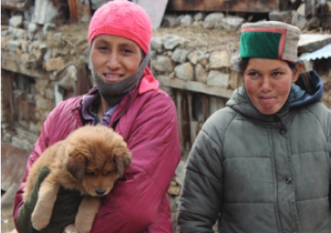
However, mountains never disappoint one with Maggi and our hunger was satiated at a different eating point. Well, one need not worry to find food as the hamlet is full of various eateries offering momos, thukpa, paranthas etc. Notably, time is the main factor to keep in mind here because shops and eating spots close early between 7pm to 8pm during the winters.
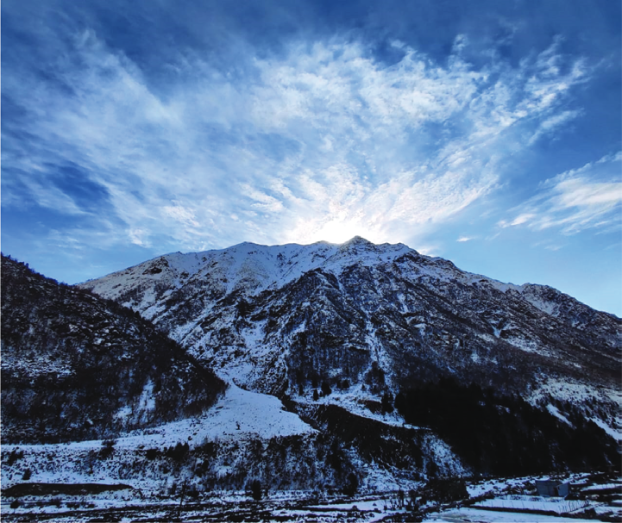
Smiling despite struggles…
Chitkul is a sheer token of Mother Nature’s blessing, away from the cacophony of bustling city life. The serenity that the place offers is the solace one can crave for. It is worth mentioning here that the magnificence of a place is not just the landscapes and tranquility but also its people. The glory of a place remains intact only in the hands of responsible inhabitants and their hospitality.

Meanwhile, in case of Chitkul, it is something you cannot overlook. Our visit being in winter also brought us closer to the challenges faced by these modest dwellers. From road conditions to food supply; water crisis to lack of tourist for several wintry months are some major issues existing at such locations. In fact, experiencing the shortage of water due to frozen water pipes and newly purchased water bottles freezing overnight distressed us thinking about the people who face this every winter. On being asked, Hansraj smiled and shared that people here are habituated to this and have been managing lives amid all such crisis. But it undoubtedly melted our hearts to see how without a single complaint we were facilitated with everything from food to hot water making our stay completely home-like that too at a very reasonable charge.
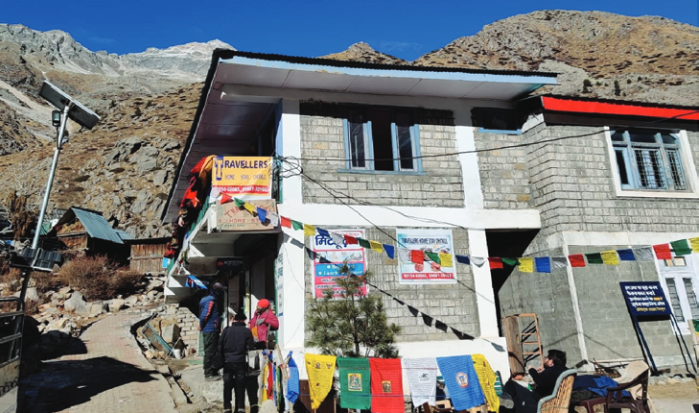
Promising to the paradise…
Well, this visit has left us wanting for more. We just couldn’t get enough of the unparalleled beauty of this valley. With the sunset and temperature dropping down, our trip also came to an end and a sudden blow of chilly wind on my face made me promise to this paradise on the earth for another visit to experience the ecstasy again.

